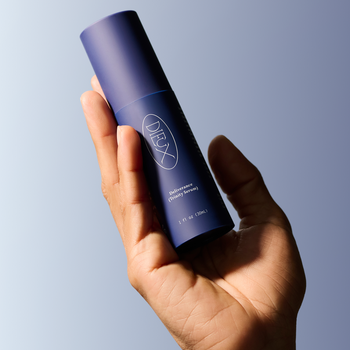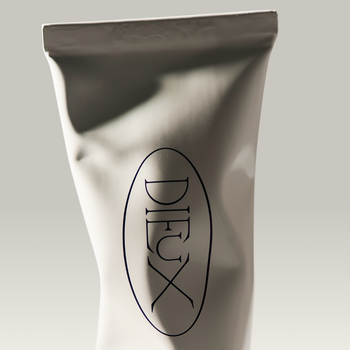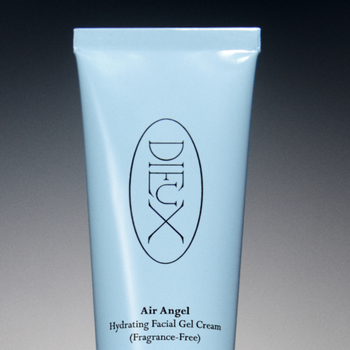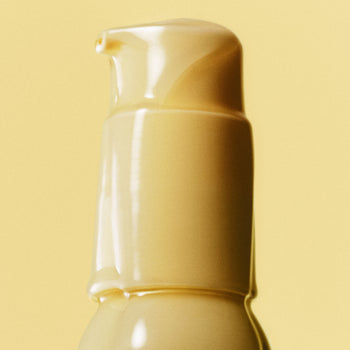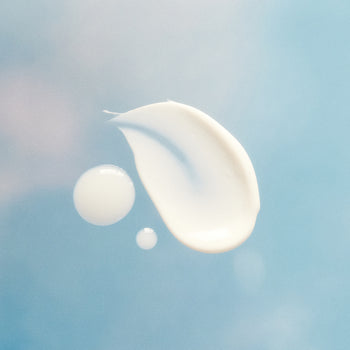
Is Chemical Sunscreen Toxic?
If you care about toxicity, the first thing to understand is that everything can be toxic. That’s not fear-mongering, that’s toxicology. Water, oxygen, even sunlight (despite giving life on Earth) can harm or kill you in excess. So when someone labels an entire ingredient or category as "toxic," the better question to ask is what their intent is.
Worried about formaldehyde in skincare? On the surface, that’s a reasonable reaction! But, keep in mind that formaldehyde is naturally found in pears, and humans (yes, you) produce it as part of normal metabolism. Even water, when over consumed, can kill you. That doesn’t make water toxic. The same logic applies to sunscreen. It’s not about the ingredient itself but the dose, the context, and the science behind how it’s used.
Is Sunscreen Toxic? Let’s Talk About the Real Problem
There’s a persistent myth in beauty that sunscreen is toxic. It stems from decades of misinformation and the fact that fear sells. Fear alone doesn’t move product, but pairing a “toxic” problem with a “detox” solution? That’s Marketing 101. The issue is that these claims rarely reflect sound science.
Organizations like the Environmental Working Group (EWG) have built entire platforms around demonizing ingredients, publishing “dirty” lists that ignore a key concept in toxicology: dose matters (in addition to peer review, AKA, they don’t have teams of independent scientists poking holes in their findings). While they raise valid concerns around how slow U.S. sunscreen regulation is, they often lose the thread when it comes to interpreting scientific data. The EWG typically starts with the right problem, but loses the plot when it comes to solutions.
Sunscreen and the FDA
In 2019 and then 2020, the FDA released an updated proposed rule for over-the-counter (OTC) sunscreens. It aimed to modernize how these products are regulated, covering everything from SPF to labeling. In that same proposal, the FDA confirmed zinc oxide and titanium dioxide as GRASE—generally recognized as safe and effective—while requesting more data for other filters.
While the FDA states clearly, and I quote, “absorption does NOT equal risk,” while advising to continue to use sunscreen, the beauty industry seized on the part they wanted to hear. The part that would help them sell more. The FDA’s ask for more information was then spun by influencers and fear-based marketers as proof that chemical sunscreens are unsafe. And wouldn’t you know it, they also happened to have a “safe” solution or product list to sell you. Zinc-based sunscreens are great, but misinterpreting what the FDA said to sell your product? Not so great.
European Protocol
Meanwhile, Europe did the work. In 2020, they investigated oxybenzone. The result was a 70+ page scientific evaluation released in 2021. The outcome? Oxybenzone wasn’t banned. Instead, they capped the percentage allowed in body products at 2.2% and in facial sunscreens at 6%. In the U.S., oxybenzone cannot exceed 6%. It’s important to note Europe has access to more innovative filters, and in the United States we are limited. Removing even one filter would make it deeply challenging to create effective sunscreens.
Environmental Impact
As for environmental impact, the waters get murkier. While some U.S. campaigns call for banning chemical sunscreens to "protect reefs," Europe considers zinc an eco-toxic ingredient. And many of the coral reef bleaching studies? They’ve been criticized for flawed methodology and poor real-world relevance. We have Dr. Michelle Wong to thank for a lot of that myth busting.
What About Boosters?
Another reason the “chemical sunscreen is toxic” narrative falls apart? Brands that push it are often using boosters that are chemical sunscreen analogues. Boosters help sunscreens spread better, last longer, and in some cases, absorb UV light. One common example is butyloctyl salicylate, which is structurally similar to octisalate, an FDA-approved UV filter. In fact, some manufacturers even promote it as a workaround to avoid sunscreen regulations while still offering UV protection and the claim “100% mineral sunscreen.” Look at the screenshot below. “No restriction” when it comes to butyloctyl salicylate, octisalate (aka ethylhexy salicylate) is restricted at 5%.

So, what’s going on here?
- Either brands don’t know their boosters act like chemical sunscreens, in which case, it’s fair to question what else they don’t know. That’s not exactly a strong position for educating consumers on toxicology.
- Or they do know and are able to market their mineral sunscreen without demonizing chemical filters. Hybrid sunscreens (blends of chemical and mineral filters) are fantastic options!
Of course, as with any topic, nuance matters. Some companies have now pivoted to demonizing boosters too, in yet another marketing ploy to sell “pure” mineral sunscreens. It’s the right concern—lack of transparency—but the wrong conclusion. Boosters are widely used, safe, and approved in multiple markets.
The truth is simple. Chemical sunscreens are safe. Mineral sunscreens are safe. Both chemical and mineral sunscreens absorb UV radiation very similarly converting it into heat. REPEAT: SUNSCREEN IS SAFE. The only reason to avoid them is if you don’t like the texture or have a sensitivity. That’s it. Fear should never be a stand in for facts.
At Dieux, we know sunscreen is good, but American sunscreen can do better. If you're a like-minded brand ready to champion newer, more innovative filters, smarter formulas, and more transparent education, email us at sunscreener@dieuxskin.com. Let’s advocate for change together.
Sources
“Benzophenone-3.” Public Health, 31 Mar. 2021,
health.ec.europa.eu/publications/benzophenone-3_en.
Center for Drug Evaluation and Research. “Shedding More Light on Sunscreen Absorption.” U.S.
Food and Drug Administration, FDA, web.archive.org/web/20200201143633/https:/www.fda.gov/news-events/fda-voices-perspectives-fda-leadership-and-experts/shedding-more-light-sunscreen-absorption. Accessed 23 June 2025.
Center for Drug Evaluation and Research. “Questions and Answers: Sunscreen Deemed Final
Order and Proposed Order.” U.S. Food and Drug Administration, FDA, www.fda.gov/drugs/understanding-over-counter-medicines/questions-and-answers-fda-posts-deemed-final-order-and-proposed-order-over-counter-sunscreen. Accessed 23 June 2025.
Clifton, Jessica. “Surprising Foods That Contain Formaldehyde: The Chemistry Blog.” ReAgent
Chemical Services, 28 May 2025, www.chemicals.co.uk/blog/what-food-is-formaldehyde-in#:~:text=Many%20fruits%20also%20contain%20formaldehyde,Coffee.
Cologna, Viktoria, et al. “Trust in Scientists and Their Role in Society across 68 Countries.”
Nature News, Nature Publishing Group, 20 Jan. 2025, www.nature.com/articles/s41562-024-02090-5.
“Colorado Expert Debunks Sunscreen Misinformation, Says It Does Not Cause Cancer.” CBS
News, CBS Interactive, www.cbsnews.com/colorado/news/debunk-sunscreen-misinformation-cancer-colorado-experts/. Accessed 23 June 2025.
Godoy, Maria. “Some Tiktok Influencers Are Maligning Sunscreen. Here’s What to Know about
the Claims.” NPR, NPR, 17 June 2024, www.npr.org/sections/shots-health-news/2024/06/17/nx-s1-5002030/sunscreen-tiktok-misinformation-melanoma.
“Is Fear an Effective Viral Marketing Tactic?” Close School of Entrepreneurship, 28 Oct. 2016,
drexel.edu/close/news/announcements/2016/October/Is%20Fear%20an%20Effective%20Viral%20Marketing%20Tactic/.
“Metal Oxide Sunscreens Protect Skin by Absorption, Not by Reflection or Scattering.”
Photodermatology, Photoimmunology & Photomedicine, U.S. National Library of Medicine, pubmed.ncbi.nlm.nih.gov/26431814/. Accessed 23 June 2025.
Patricia, et al. “Is Your Sunscreen Killing Coral Reefs? The Science.” Lab Muffin Beauty Science, 6
June 2025, labmuffin.com/is-your-sunscreen-killing-coral-the-science-with-video/.
Plesset, Anna. “Is Sunscreen Helpful or Harmful?” NewYork-Presbyterian, 19 Nov. 2024,
healthmatters.nyp.org/is-sunscreen-helpful-or-harmful/.
Program, Human Foods. “Generally Recognized as Safe (GRAS).” U.S. Food and Drug
Administration, FDA, www.fda.gov/food/food-ingredients-packaging/generally-recognized-safe-gras. Accessed 23 June 2025.
“Public Health Statement.” Toxicological Profile for Formaldehyde., U.S. National Library of
Medicine, www.ncbi.nlm.nih.gov/books/NBK597648/. Accessed 23 June 2025.
Scaturro, Michael. “Other Countries Have Better Sunscreens. Here’s Why We Can’t Get Them in
the U.S.” NPR, NPR, 18 May 2024, www.npr.org/sections/health-shots/2024/05/18/1251919831/sunscreen-effective-better-ingredients-fda.
“Shining a Light on Sun Safety: Debunking TikTok’s Anti-Sunscreen Claims.” Herbert Irving
Comprehensive Cancer Center (HICCC) - New York, 8 Apr. 2025, www.cancer.columbia.edu/news/shining-light-sun-safety-debunking-tiktoks-anti-sunscreen-claims.
Sunjin Beauty Science, 20 Nov. 2023, sunjinbs.com/?p=5960.
What Gen Z Gets Wrong About Sunscreen (Published 2024),
www.nytimes.com/2024/05/27/well/live/sunscreen-skin-cancer-gen-z.html. Accessed 23 June 2025.
Wharton, Claire, and Amelia Smit. “Are Chemical Sunscreens Safe to Use?” Are Chemical
Sunscreens Safe to Use? | Cancer Council, 15 Jan. 2025, www.cancer.org.au/iheard/are-chemical-sunscreens-safe-to-use.
